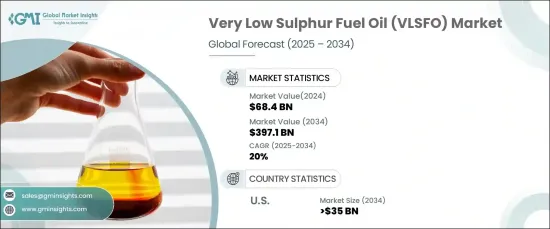
|
市場調査レポート
商品コード
1666638
超低硫黄燃料油市場の機会、成長促進要因、産業動向分析、2025~2034年の予測Very Low Sulphur Fuel Oil (VLSFO) Market Opportunity, Growth Drivers, Industry Trend Analysis, and Forecast 2025 - 2034 |
||||||
カスタマイズ可能
|
|||||||
| 超低硫黄燃料油市場の機会、成長促進要因、産業動向分析、2025~2034年の予測 |
|
出版日: 2024年12月26日
発行: Global Market Insights Inc.
ページ情報: 英文 110 Pages
納期: 2~3営業日
|
全表示
- 概要
- 目次
世界の超低硫黄燃料油市場は、2024年に684億米ドルと評価され、2025年から2034年までのCAGRは20%と予想され、大幅な拡大が見込まれています。
この市場の急成長は、2020年以降に国際海事機関(IMO)が施行した厳しい硫黄排出規制によるところが大きいです。この規制により、世界中の船会社は、新しい硫黄含有量基準に適合した、よりクリーンな代替船舶燃料であるVLSFOへの移行を求められています。この移行は、低硫黄燃料の需要を押し上げるだけでなく、製油所がこれらの進化する基準を満たすために生産能力を強化することを促し、市場の成長をさらに促進しています。

海運セクターは急速に成長しており、環境意識の高まりもVLSFO需要の増加に寄与しています。持続可能な海運慣行は、二酸化炭素排出量の削減と海洋生態系の保護を目的として、これまで以上に中心的な課題となっています。環境に優しい燃料へのシフトは、こうした目的に完全に合致しています。欧州やアジア太平洋などの主要地域でバンカリング施設が増え、船舶の往来が活発化するにつれ、VLSFO市場はこれらの地域で広く採用されるようになっています。企業は、環境規制の遵守を確保しながら運航効率を最適化するために革新的な技術に投資しており、これによって市場の継続的な拡大が確保されています。
| 市場範囲 | |
|---|---|
| 開始年 | 2024 |
| 予測年 | 2025-2034 |
| 開始金額 | 684億米ドル |
| 予測金額 | 3,971億米ドル |
| CAGR | 20% |
既存の船舶を低硫黄推進技術で改造する動向が、VLSFOの需要をさらに押し上げています。海上旅客輸送が引き続き増加し、地域港湾も発展しているため、市場の軌道は引き続き良好です。さらに、政府による海軍艦隊、特に空母や潜水艦のような軍用艦艇の防衛分野での拡大投資は、これらの分野でもVLSFOの需要を増加させる可能性が高いと思われます。
米国では、超低硫黄燃料油(VLSFO)市場は2034年までに350億米ドルに達すると予測されています。低硫黄燃料の需要増加は、硫黄排出規制の強化と、新基準を満たす製油所の近接化によってもたらされています。さらに、地域の規制がよりクリーンな燃料の採用を促進する一方、海上活動による汚染を削減する必要性がVLSFOの需要をさらに押し上げています。豪華さと信頼性を提供する船舶への需要の高まりに伴い、運航信頼性への注目が高まっていることも、市場の成長を後押しし続けています。経済の安定が続き、環境に優しい海運への注目が高まる中、米国のVLSFO市場は今後10年間も繁栄を続けると予想されます。
目次
第1章 調査手法と調査範囲
- 市場の定義
- 基本推定と計算
- 予測計算
- データソース
- 1次データ
- 2次データ
- 有償
- 公的
第2章 エグゼクティブサマリー
第3章 業界洞察
- エコシステム分析
- 規制状況
- 業界への影響要因
- 促進要因
- 業界の潜在的リスク&課題
- 成長可能性分析
- ポーターの分析
- 供給企業の交渉力
- 買い手の交渉力
- 新規参入業者の脅威
- 代替品の脅威
- PESTEL分析
第4章 競合情勢
- イントロダクション
- 戦略ダッシュボード
- イノベーションと持続可能性の展望
第5章 市場規模・予測:地域別、2021年~2034年
- 主要動向
- 北米
- 米国
- カナダ
- 欧州
- スペイン
- ロシア
- 英国
- イタリア
- フランス
- ドイツ
- ベルギー
- オランダ
- アジア太平洋
- 中国
- 日本
- 韓国
- インド
- オーストラリア
- シンガポール
- 中東・アフリカ
- UAE
- サウジアラビア
- トルコ
- 南アフリカ
- ラテンアメリカ
- ブラジル
- メキシコ
- アルゼンチン
第6章 企業プロファイル
- BP
- Chevron
- Exxon Mobil
- Hindustan Petroleum
- Indian Oil
- Marathon Petroleum
- Mediterranean Fuels
- Phillips 66
- Rosneft
- Saudi Aramco
- Shell
- Sinopec
- TotalEnergies
- Viva Energy
- Vitol
The Global Very Low Sulphur Fuel Oil Market, valued at USD 68.4 billion in 2024, is poised for significant expansion, with an expected CAGR of 20% from 2025 to 2034. This market surge is largely driven by the stringent sulphur emission regulations enforced by the International Maritime Organization (IMO) since 2020. These regulations require shipping companies worldwide to transition to VLSFO, a cleaner marine fuel alternative that complies with the new sulphur content standards. This shift is not only pushing the demand for low-sulphur fuels but also prompting refineries to enhance their production capabilities to meet these evolving standards, further fueling market growth.

Beyond regulatory drivers, the maritime sector is growing rapidly, with rising environmental awareness also contributing to the increased demand for VLSFO. Sustainable shipping practices are now more than ever a central focus, with the aim to reduce carbon emissions and protect marine ecosystems. The shift toward eco-friendly fuels aligns perfectly with these objectives. As more bunkering facilities become available and vessel traffic intensifies in key regions like Europe and Asia-Pacific, the VLSFO market is seeing widespread adoption across these regions. Companies are investing in innovative technologies to optimize operational efficiency while ensuring compliance with environmental regulations, thus ensuring continued market expansion.
| Market Scope | |
|---|---|
| Start Year | 2024 |
| Forecast Year | 2025-2034 |
| Start Value | $68.4 Billion |
| Forecast Value | $397.1 Billion |
| CAGR | 20% |
The trend toward retrofitting existing vessels with low-sulphur propulsion technologies is boosting the VLSFO demand even further. As seaborne passenger traffic continues to grow and regional ports develop, the market's trajectory remains positive. In addition, government investments in expanding naval fleets, particularly in the defense sector with military vessels such as aircraft carriers and submarines, will likely increase the demand for VLSFO in these segments as well.
In the U.S., the Very Low sulphur Fuel Oil (VLSFO) market is projected to reach USD 35 billion by 2034. The increasing demand for low-sulphur fuels is being driven by tighter sulphur emission regulations and the proximity of refineries that can meet the new standards. Additionally, local regulations are fostering the adoption of cleaner fuels, while the need to reduce pollution from seaborne activities is further pushing the demand for VLSFO. The growing focus on operational reliability, in line with the rising demand for vessels that offer luxury and dependability, continues to fuel the market's growth. With ongoing economic stability and a stronger focus on eco-friendly shipping, the U.S. VLSFO market is expected to continue flourishing in the coming decade.
Table of Contents
Chapter 1 Methodology & Scope
- 1.1 Market definitions
- 1.2 Base estimates & calculations
- 1.3 Forecast calculation
- 1.4 Data sources
- 1.4.1 Primary
- 1.4.2 Secondary
- 1.4.2.1 Paid
- 1.4.2.2 Public
Chapter 2 Executive Summary
- 2.1 Industry synopsis, 2021 - 2034
Chapter 3 Industry Insights
- 3.1 Industry ecosystem analysis
- 3.2 Regulatory landscape
- 3.3 Industry impact forces
- 3.3.1 Growth drivers
- 3.3.2 Industry pitfalls & challenges
- 3.4 Growth potential analysis
- 3.5 Porter's analysis
- 3.5.1 Bargaining power of suppliers
- 3.5.2 Bargaining power of buyers
- 3.5.3 Threat of new entrants
- 3.5.4 Threat of substitutes
- 3.6 PESTEL analysis
Chapter 4 Competitive Landscape, 2024
- 4.1 Introduction
- 4.2 Strategic dashboard
- 4.3 Innovation & sustainability landscape
Chapter 5 Market Size and Forecast, By Region, 2021 – 2034 (USD Million)
- 5.1 Key trends
- 5.2 North America
- 5.2.1 U.S
- 5.2.2 Canada
- 5.3 Europe
- 5.3.1 Spain
- 5.3.2 Russia
- 5.3.3 UK
- 5.3.4 Italy
- 5.3.5 France
- 5.3.6 Germany
- 5.3.7 Belgium
- 5.3.8 Netherlands
- 5.4 Asia Pacific
- 5.4.1 China
- 5.4.2 Japan
- 5.4.3 South Korea
- 5.4.4 India
- 5.4.5 Australia
- 5.4.6 Singapore
- 5.5 Middle East & Africa
- 5.5.1 UAE
- 5.5.2 Saudi Arabia
- 5.5.3 Turkey
- 5.5.4 South Africa
- 5.6 Latin America
- 5.6.1 Brazil
- 5.6.2 Mexico
- 5.6.3 Argentina
Chapter 6 Company Profiles
- 6.1 BP
- 6.2 Chevron
- 6.3 Exxon Mobil
- 6.4 Hindustan Petroleum
- 6.5 Indian Oil
- 6.6 Marathon Petroleum
- 6.7 Mediterranean Fuels
- 6.8 Phillips 66
- 6.9 Rosneft
- 6.10 Saudi Aramco
- 6.11 Shell
- 6.12 Sinopec
- 6.13 TotalEnergies
- 6.14 Viva Energy
- 6.15 Vitol

